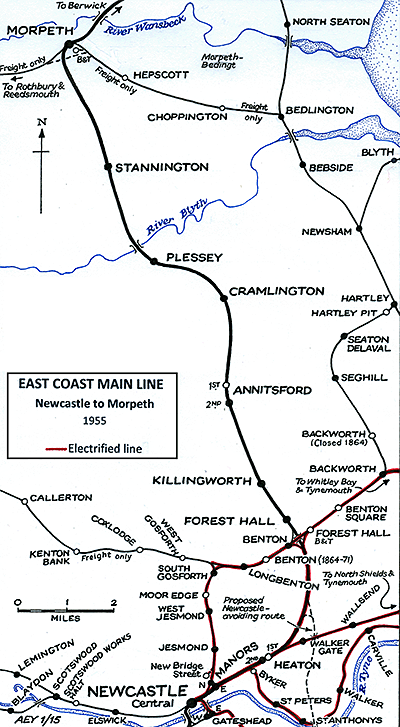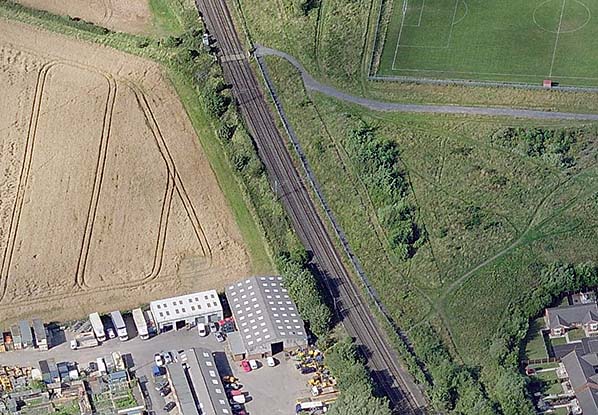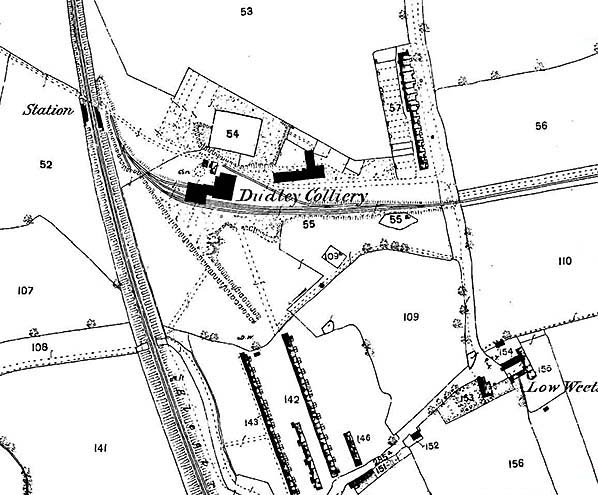Notes: It seems that this station enjoyed only three months as ‘Annitsford’; in its short life of about 18 years it carried three names. Although the East Coast main line opened between Newcastle and Tweedmouth in 1847 it was not until April 1860 that Bradshaw showed this station, and it first appeared as Dudley; several other stations, such as Forest Hall (originally Benton) and Goswick (originally Wind Mill Hill) were also afterthoughts. The station’s principal role was to serve the adjacent Dudley Colliery, which had opened in 1856, and the small mining village a short distance to the south.
 Bradshaw of February 1863 shows that Dudley was served by three Monday-to-Friday up (southbound) trains departing at 8,52am, 2.27pm and 8.10pm, which called at every station from Berwick to Newcastle, with an extra on Saturday at 8.52am. One train called on Sunday at 8.50am. The down train service had the same frequency, with Monday-to-Friday calls by Berwick trains at 9.22am, 1.42pm and 6.52pm, with an additional Saturday departure at 3.52pm which ran as far as Widdrington. On Sunday a train for Berwick called at Dudley at 6.48pm. Bradshaw of February 1863 shows that Dudley was served by three Monday-to-Friday up (southbound) trains departing at 8,52am, 2.27pm and 8.10pm, which called at every station from Berwick to Newcastle, with an extra on Saturday at 8.52am. One train called on Sunday at 8.50am. The down train service had the same frequency, with Monday-to-Friday calls by Berwick trains at 9.22am, 1.42pm and 6.52pm, with an additional Saturday departure at 3.52pm which ran as far as Widdrington. On Sunday a train for Berwick called at Dudley at 6.48pm.
No photographs or drawings have been found of the station structures. It seems that the station was not shown as open on Ordnance Survey maps, but on editions from 1895/97 buildings are shown at the correct site on each side of the main line. It can safely be assumed that the facilities were inadequate and inconveniently placed to serve the expanding colliery village, because in 1876 the NER commissioned a design for a new station. Presumably to avoid confusion with Dudley Hill (West Riding) and the much more important Dudley (Worcestershire), the Northumbrian station had been renamed Dudley Colliery on 1 September 1874. The North Eastern Railway (NER) was not averse to renaming stations to avoid duplication of names with its own, or other companies’, stations, even if the name of a distant settlement was chosen. The addition of ‘Colliery’ to the name must not have removed potential confusion, so on 8 July 1878 the entirely different name of Annitsford was adopted. This was a hamlet almost a mile to the east, and the NER eschewed the spelling ‘Annet’s Ford’ which was used on a contemporary Ordnance Survey map. It is strange that the NER took the trouble to change the name only three months before the station closed, to be replaced with a new Annitsford station 16 chains (352yd) to the south. The dates of renaming are taken from Quick (2009): see Bibliography. The first Annitsford station is not thought to have handled goods traffic, although much mineral traffic travelled from the nearby Dudley Colliery.
After closure, the map evidence stated above suggests that the buildings of the first Annitsford station survived into the 1890s. The signal box, whose construction was proposed in 1873 and which stood immediately north of the station and close to the sidings serving the colliery, was at first known as ‘Annitsford Colliery Junction’ but was later to carry the former name of the first station, ‘Dudley Colliery’ until its closure in January 1980. The colliery itself closed in 1977.
Route map drawn by Alan Young.
Click here for a brief history of the East Coast Main Line
in Northumberland.
BIBLIOGRAPHY:
- Addyman, John F (Editor) A history of the Newcastle & Berwick Railway (North Eastern Railway Association, 2011) – especially Chapter 5 ‘The buildings’ by Bill Fawcett
- Biddle, Gordon Victorian stations (David & Charles, 1973)
- Biddle, Gordon Britain’s historic railway buildings (Oxford University Press, 2003)
- Fawcett, Bill A history of North Eastern Railway architecture Vol 1: The Pioneers (North Eastern Railway Association 2001)
- Young, Alan Railways in Northumberland (Martin Bairstow, 2003)
- Young, Alan Lost stations of Northumberland & Durham (Silver Link 2011)
See other ECML stations:Tweedmouth, Scremerston, Goswick, Beal, Smeafield, Crag Mill, Belford, Lucker,
Newham, Fallodon, Little Mill, Christon Bank,
Longhoughton, Lesbury, Warkworth, Longhirst, Ashington Colliery Junction, Morpeth, Plessey, Annitsford (2nd), Killingworth, Forest Hall, Heaton (2nd), Heaton (1st), Durham, Croft Spa, Eryholme, Otterington, Alne & Tollerton |



 Bradshaw of February 1863 shows that Dudley was served by three Monday-to-Friday up (southbound) trains departing at 8,52am, 2.27pm and 8.10pm, which called at every station from Berwick to Newcastle, with an extra on Saturday at 8.52am. One train called on Sunday at 8.50am. The down train service had the same frequency, with Monday-to-Friday calls by Berwick trains at 9.22am, 1.42pm and 6.52pm, with an additional Saturday departure at 3.52pm which ran as far as Widdrington. On Sunday a train for Berwick called at Dudley at 6.48pm.
Bradshaw of February 1863 shows that Dudley was served by three Monday-to-Friday up (southbound) trains departing at 8,52am, 2.27pm and 8.10pm, which called at every station from Berwick to Newcastle, with an extra on Saturday at 8.52am. One train called on Sunday at 8.50am. The down train service had the same frequency, with Monday-to-Friday calls by Berwick trains at 9.22am, 1.42pm and 6.52pm, with an additional Saturday departure at 3.52pm which ran as far as Widdrington. On Sunday a train for Berwick called at Dudley at 6.48pm.
 Home Page
Home Page